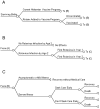The cost-effectiveness of rotavirus vaccination in Malawi
- PMID: 20684689
- PMCID: PMC3962285
- DOI: 10.1086/653578
The cost-effectiveness of rotavirus vaccination in Malawi
Abstract
Background: Rotarix (GlaxoSmithKline), a newly licensed rotavirus vaccine requiring 2 doses, may have the potential to save hundreds of thousands of lives in Africa. Nations such as Malawi, where Rotarix is currently under phase III investigation, may nevertheless face difficult economic choices in considering vaccine adoption.
Methods: The cost-effectiveness of implementing a Rotarix vaccine program in Malawi was estimated using published estimates of rotavirus burden, vaccine efficacy, and health care utilization and costs.
Results: With 49.5% vaccine efficacy, a Rotarix program could avert 2582 deaths annually. With GAVI Alliance cofinancing, adoption of Rotarix would be associated with a cost of $5.07 per disability-adjusted life-year averted. With market pricing, Rotarix would be associated with a base case cost of $74.73 per disability-adjusted life-year averted. Key variables influencing results were vaccine efficacy, under-2 rotavirus mortality, and program cost of administering each dose.
Conclusions: Adopting Rotarix would likely be highly cost-effective for Malawi, particularly with GAVI support. This finding holds true across uncertainty ranges for key variables, including efficacy, for which data are becoming available.
Conflict of interest statement
Potential conflicts of interest: none reported.
Figures





Similar articles
-
Cost-Effectiveness of Monovalent Rotavirus Vaccination of Infants in Malawi: A Postintroduction Analysis Using Individual Patient-Level Costing Data.Clin Infect Dis. 2016 May 1;62 Suppl 2(Suppl 2):S220-8. doi: 10.1093/cid/civ1025. Clin Infect Dis. 2016. PMID: 27059360 Free PMC article.
-
Cost-effectiveness of a new rotavirus vaccination program in Pakistan: a decision tree model.Vaccine. 2013 Dec 9;31(51):6072-8. doi: 10.1016/j.vaccine.2013.10.022. Epub 2013 Oct 29. Vaccine. 2013. PMID: 24176497 Free PMC article.
-
Re-evaluating the cost and cost-effectiveness of rotavirus vaccination in Bangladesh, Ghana, and Malawi: A comparison of three rotavirus vaccines.Vaccine. 2018 Nov 26;36(49):7472-7478. doi: 10.1016/j.vaccine.2018.10.068. Epub 2018 Oct 25. Vaccine. 2018. PMID: 30420039 Free PMC article.
-
Rotavirus vaccine: a cost effective control measure for India.Hum Vaccin Immunother. 2012 Apr;8(4):501-4. doi: 10.4161/hv.18862. Hum Vaccin Immunother. 2012. PMID: 23071989 Review.
-
Insights from global data for use of rotavirus vaccines in India.Vaccine. 2014 Aug 11;32 Suppl 1(Suppl 1):A171-8. doi: 10.1016/j.vaccine.2014.03.029. Vaccine. 2014. PMID: 25091672 Free PMC article. Review.
Cited by
-
Cost-effectiveness analysis of rotavirus vaccination among Libyan children using a simple economic model.Libyan J Med. 2014 Dec 9;9(1):26236. doi: 10.3402/ljm.v9.26236. eCollection 2014. Libyan J Med. 2014. PMID: 25499622 Free PMC article.
-
Systematic Review and Meta-Analysis of Cost-effectiveness of Rotavirus Vaccine in Low-Income and Lower-Middle-Income Countries.Open Forum Infect Dis. 2019 Mar 8;6(4):ofz117. doi: 10.1093/ofid/ofz117. eCollection 2019 Apr. Open Forum Infect Dis. 2019. PMID: 31049363 Free PMC article.
-
Rotavirus vaccine RIX4414 (Rotarix™): a pharmacoeconomic review of its use in the prevention of rotavirus gastroenteritis in developing countries.Pharmacoeconomics. 2011 Nov;29(11):989-1009. doi: 10.2165/11207210-000000000-00000. Pharmacoeconomics. 2011. PMID: 21988293 Review.
-
Pharmacoeconomic spotlight on rotavirus vaccine RIX4414 (Rotarix™) in the prevention of rotavirus gastroenteritis in developing countries.Paediatr Drugs. 2012 Dec 1;14(6):429-33. doi: 10.2165/11207500-000000000-00000. Paediatr Drugs. 2012. PMID: 23013458 Review.
-
Systematic review of the economic value of diarrheal vaccines.Hum Vaccin Immunother. 2014;10(6):1582-94. doi: 10.4161/hv.29352. Epub 2014 May 27. Hum Vaccin Immunother. 2014. PMID: 24861846 Free PMC article.
References
-
- Bernstein DI. Rotavirus overview. Pediatr Infect Dis J. 2009;28(3 Suppl):S50–S53. - PubMed
-
- Meeting of the Immunization Strategic Advisory Group of Experts April 2009: conclusions and recommendations. Wkly Epidemiol Rec. 2009;84(23):220. - PubMed
-
- Introduction of rotavirus vaccine with support from the GAVI Alliance: information to assist the national decision-making and application process. http://www.gavialliance.org/resources/RVP_GAVI_InfoPack_17Jan08.pdf. [13 March 2009].
-
- Cunliffe NA, Gondwe JS, Kirkwood CD, et al. Effect of concomitant HIV infection on presentation and outcome of rotavirus gastroenteritis in Malawian children. Lancet. 2001;358(9281):550–555. - PubMed
Publication types
MeSH terms
Substances
Grants and funding
LinkOut - more resources
Full Text Sources
Medical

